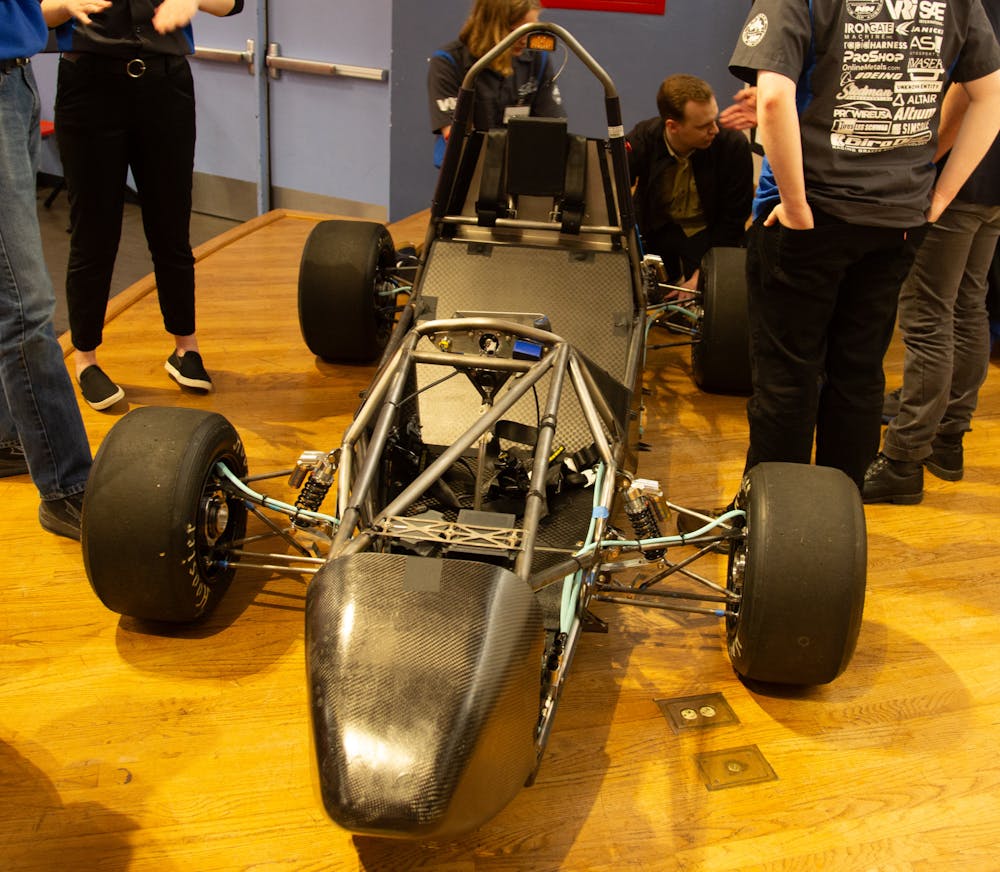WWU Racing is a club on campus that creates custom-built race cars to take across America for competition against other teams. This year’s car, Viking 66, is the program’s third electric vehicle that they have built to compete at Formula SAE in the electric vehicle class at Michigan International Speedway, June 11-15.
Formula SAE, formerly known as Society of Automotive Engineers, is a challenge where teams design, build, test and ultimately race formula-style cars.
In 2020, the WWU racing team found themselves with lots of time during the pandemic, but lacked access to a lab space. It was during this time the team made the decision to switch to an electric vehicle.
“Electric vehicles are hard,” Megan Ellis, the team’s project manager, said.
When working on an internal combustion engine, problem solving can be as easy as watching a YouTube video; with electric cars, it isn’t always as straightforward.
“It is something that the [electric vehicle industry] is just starting to break the barriers of, and so the fact that we are doing it as college students means that a lot of the work we are doing has only been around for the past five to 10 years,” Ellis said.
Building a race car from scratch is no easy feat, just ask the team who estimates the build time of this year's vehicle to be in the thousands of hours.
“20 people easily each spend 30 hours a week on it,” Technical Director Luke Grant said. “You could do the math on it, it’s thousands for sure.”

Evan Wren, WWU Racing’s business director, wearing the team’s sweatshirt which features their sponsors on the back. Taken at the Viking 66 unveiling event at WWU on April 27, 2024, in Bellingham, Wash. // Photo by Aidan Fox-Bailey
The team spends fall quarter on design, winter quarter on manufacturing and the spring quarter on testing the vehicle before competition.
“Communicating with our alumni and the department is essential in keeping the team functioning. Otherwise, it's impossible to try to figure things out on your own in a bubble,” Evan Wren, the team’s business director, said.
While the team considers all of its previous vehicles to be successes in furthering the knowledge and advancement of the program, the previous two iterations of the electric race car were unable to compete.
Viking 63 was the first car to come from this new electric era, and as the racing team's first venture into this new field, it didn’t all go as planned.
“63 didn’t move, it was a paperweight, it wasn’t a car,” Grant said. “64 ran, and so from that perspective it is still the furthest we’ve ever come and is still a success in that way.”
Viking 64 was the team’s first functioning EV, and made it to Michigan for race day where it failed certain elements of vehicle safety inspections with issues relating to the battery management system.

Felix Gonzalez explains a portion of the car’s structure system to an attendant of Viking 66’s unveiling event. The event was held in Artzen Hall at WWU in Bellingham, Wash., on April 27, 2024. // Photo by Aidan Fox-Bailey
As the team prepares to take Viking 66 to competition, the team’s leadership reflects on the progress WWU Racing has made throughout their EV development journey.
“We’re standing on the shoulders of giants and I think that’s going to speak for itself when we get out on the track,” Grant said.
Being able to rely on the team’s extensive network of alumni and sponsor connections has been essential for the team’s progress in EV development.
“Our alumni have gone off to work in the industry and they’ve gotten a whole host of new knowledge through their employment, and they’ve been able to come back with new insights for us,” Wren said.
Despite the regulatory hiccups that prevented last year's car from competing on race day, the team did not miss a beat in evaluating what went right, what went wrong and preparing to go back this year. Melana Evans, WWU Racing’s electronics chief engineer, led the charge in redeveloping these systems to insure the team’s success at competition this year.
“Probably just a week later everyone was buckling down figuring out how to fix the things that went wrong for the next car, and we’re really seeing the fruits of that labor,” Grant said. “I think this is by far the closest we’ve ever come to a rules-legal functioning EV. I’m really confident the team’s going to make it happen now.”
If you are interested in getting involved with the racing team, the program is always looking for new students to get involved, and the team is open to students of all majors. WWU Racing is located in the Ross Engineering and Technology Building in room 155 on Western’s campus.
Aidan Fox-Bailey is a sports and recreation reporter for The Front. He is a third-year student majoring in journalism and public relations with a political science minor. When not reporting, he enjoys watching baseball, eating delicious food and hanging out with friends. He can be reached at aidanfoxbailey.thefront@gmail.com.






